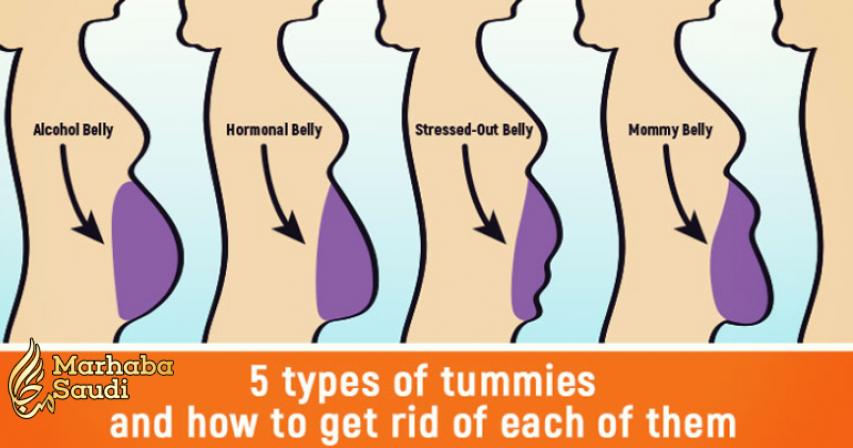5 Types Of Tummies And How To Get Rid Of Each Of Them

According to Health.com, excess abdominal fat, or what others call “unwanted belly fat,” is a predictor of heart diseases, insulin resistance, type 2 diabetes, and even several cancers. Each of those diseases and conditions affects your health in a negative way and can also become fatal if you don’t take care of that excess belly fat. But in order to take care of it, you must first figure out what type of belly you have. Once you identify that, you can take the next steps to getting rid of it. Below you will find the most common types of bellies and how you can get rid of them.
1. Alcohol Belly: Nothing can be more soothing than a nice gold alcoholic beverage on a hot summer day. But when one beer turns into another and another, and this becomes a daily routine for you, you’re not doing any favors to your waistline. Psychology Today explains that at 7 calories per gram, alcohol contains nearly twice as much as that, as well as four carbohydrates per gram. The problem here is that the body stores carbohydrates and fat as glycogen (another form of sugar) in the liver and muscle. They add that the body cannot store alcohol, unfortunately, so when consumed, it must be burnt immediately.
To get rid of it, the first thing you might want to do is tone down the drinking. According to the Centers for Disease Control and Prevention, the 2015-2020 U.S. Dietary Guidelines for Americans recommends that men should consume no more than two alcoholic drinks per day, and women should consume no more than one alcoholic drink per day. The second thing, according to Tom Cowen, head personal trainer for Xercise4less, is “to have a state of negative energy balance – burn more calories than you’re consuming,” he told the Daily Star.
2. Post Pregnancy Belly: Granted, after a woman gives birth, there will be some excess fat. But recent research has suggested that the extra weight may not only be from pregnancy, but rather the result of poor lifestyle choices following the pregnancy. A study, which is published in the journal Women’s Health Issues, conducted a study to see if there was an association between excess belly weight and post pregnancy lifestyle choices. The study consisted of over 32,000 women with at least two births in Wisconsin between 2006 and 2013.
What Olga Yakusheva, the study’s lead author, and her colleagues found was that in the study, each woman gained almost two pounds a year because of their age. But what they found troubling is that once their babies became toddlers; the mothers gained a full extra pound annually compared to their childless peers. In a press release with Michigan News, Yakusheva explains why she believes this occurred, “Mothers tend to put the needs of their children first, so they might not be exercising or taking care of themselves,” she said. “It might also be little things like finishing the food on their child’s plate or spending more time sitting with their kids reading or watching a movie.”
To get rid of that excess fat, Dr. Kara Mohr, an exercise psychologist, and fitness expert, told Fitness Magazine: “I would suggest increasing the intensity of your cardio workouts, making sure you include intervals (alternating walking with fast walking or sprinting). And be sure your strength training includes combination moves that work multiple muscles including the core (plank rows, push-ups, squat with military press, etc) rather than single muscle groups.”
3. Stress Belly: The Daily Mail reports that a stressful life could contribute to excess weight in the abdominal area. They spoke to health expert Jackie Wicks, co-author of new book Cheats & Eats: Lifestyle Programme, and she explained to them that cortisol, which is also called the stress hormone, becomes too high for a lengthy period of time, and can increase the amount of fat stored in the stomach. So the key to losing that excess stomach fat caused by stress is to try and destress yourself. Wicks recommends taking a hot bath on a regular basis. She explains that they have been shown to lower cortisol levels. She also adds that going for a walk every day not only helps burn calories but can also be a great way to clear your mind, the Daily Mail reported.
4. Hormonal Belly: According to Rachel Attard, a certified personal trainer and nutritionist, a hormonal imbalance can contribute to weight gain. She explains how estrogen and progesterone can cause weight gain. The first point she makes is that high estrogen levels can increase insulin, which can lead to sugar cravings. This is why you see many women eat chocolate during PMS. Another point she makes is that high levels of estrogen have the ability to cause more fatty tissue growth. In most cases, she states that the excess fat is usually around the stomach area because estrogen also dictates where the body will distribute fat.
...[ Continue to next page ] / Source: mesmerizingwords






Comments